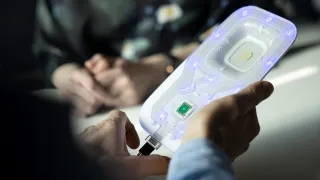Companies' development and uptake of sustainable circular economy solutions is a key part of the European Green Deal. This requires a broad and systemic understanding of circular solutions' sustainability impacts, opportunities and risks along product value chains.
Several new regulative initiatives are creating pressure to design new, more sustainable solutions. For example, the proposal for a new Ecodesign for Sustainable Products Regulation (ESPR), published in 2022 to revise the current Ecodesign Directive, will extend product-related sustainability regulation to additional sectors, such as electronics. Currently, their design is based on business models built on short product lifespans and minimum repairability of products.
TactoTek, a 2011 established Finnish injection-moulded structural electronics (IMSE) technology company and VTT Technical Research Centre of Finland set out to solve the challenge of developing a more sustainable circular economy business. TactoTek wanted to understand better the environmental impacts over its product's life cycle, assess the opportunities and challenges of different circular economy scenarios, and examine how sustainable circular economy business models would change the company's operations and approach to sustainability challenges, also at the strategic level.
System dynamic modelling supports understanding circularity potential through the value chain
VTT’s system dynamics approach brings together the impacts of circular strategies (also referred to as the R strategies) at the product and supply chain levels, enabling scrutinizing various trade-offs that typically are encountered in making design choices for more sustainable products, services and business models.
With TactoTek, the approach was applied to analyse the economic, environmental and material flow impacts of three circular strategies. The strategies analysed focused on the use of bio-based plastics, fully circular end-of-life treatment, and product lifetime extension.
VTT’s approach has provided us with a comprehensive study of our value chain from a sustainability perspective. System dynamic modelling allowed us to gain insights into different circular strategies, understanding their order of magnitude and impact on our operations, explains TactoTek’s Manager, Product Planning & Sustainability, Sampo Pirilä.
Both the modelling process, the modelling results and other insights on the perceived performance of the different circular strategies provide valuable information for company decision-making, confirms Jyri Hanski, VTT’s Senior Scientist.
Overall, the system dynamic modelling can provide well-founded, fact-based information on environmental and economic impacts, drivers, obstacles and opportunities. The process can support companies in circular design and in developing capabilities to produce and disclose sustainability-related information that will be required, for example, for digital product passports (DPPs) under the ESPR.
Understanding circular economy value creation potential supports strategic decision-making
In collaboration with TactoTek, the system dynamic examination was expanded with business model perspectives to understand the strategic significance of sustainability in business. Together with VTT's sustainable business experts, TaktoTek’s circular economy value creation potential and strategic sustainability aspects were discussed and elaborated on in two workshops. Considering the requirements of the recently introduced Corporate Sustainability Reporting Directive (CSRD), TactoTek’s stakeholders and novel ways for their engagement and stakeholder collaboration practices were discussed. Material sustainability matters were identified, and sustainability value propositions and related business models were discussed and elaborated.
The core of our business value proposition lies in the environmental performance of IMSE technology explains Pirilä and continues: Collaborative workshops with VTT's experts have provided us with fresh perspectives on how to further enhance our sustainability value. Through these sessions, we've recognized the significance of stakeholder engagement and open data sharing across the entire value chain as crucial steps toward the future of sustainable business.
VTT’s Research Team Leader Päivi-Kivikytö Reponen emphasises the importance of holistic, science-based approaches that build on multilevel collaboration and expertise: In addition to in-depth technological know-how, we at VTT have strong multidisciplinary scientific and practical expertise to support businesses in sustainable business model, product and service design. We are committed to sharing this expertise with different businesses and the broader society.
Contact details
Sampo Pirilä
Manager, Product Planning & Sustainability
[email protected]
+358405891004
System dynamic modelling:
Jyri Hanski, Senior Scientist
+358401439885
[email protected]
Circular design:
Päivi Kivikytö-Reponen, Research Team Leader
+358404835785
[email protected]
Business models and strategic sustainability:
Annu Markkula, Senior Scientist
+358503207952
[email protected]




